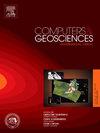Marine gravity gradient model calculation based on wavelet numerical integration and CUDA parallel
IF 4.2
2区 地球科学
Q1 COMPUTER SCIENCE, INTERDISCIPLINARY APPLICATIONS
引用次数: 0
Abstract
Compared to traditional gravity observations, the disturbing gravity gradient captures more high-frequency information from the Earth's gravity field. Due to the difficulty in directly obtaining gravity gradient measurements, we can calculate the gravity gradient by the Stokes integral methodology. However, this computational process faces two main issues: 1) Obtaining an analytical expression from the integral of the original function is difficult, necessitating the use of numerical integration methods; and 2) Large volumes of data can lead to reduced computational speed. In our study, Chebyshev wavelet numerical integration is employed to improve the integration accuracy in calculating the disturbing gravity gradient. We also provide the derivation process for nodes and weights based on the Chebyshev wavelet integral. Concurrently, the Compute Unified Device Architecture (CUDA) enables parallel computing on the Graphics Processing Unit (GPU) to improve computational speed. We detail the application of these techniques and translate theoretical concepts into a practical computational program. Experiments conducted on marine area data illustrate that integrating Chebyshev wavelet numerical integration with CUDA parallel computing not only ensures precise calculations but also significantly boosts computational efficiency.
求助全文
约1分钟内获得全文
求助全文
来源期刊

Computers & Geosciences
地学-地球科学综合
CiteScore
9.30
自引率
6.80%
发文量
164
审稿时长
3.4 months
期刊介绍:
Computers & Geosciences publishes high impact, original research at the interface between Computer Sciences and Geosciences. Publications should apply modern computer science paradigms, whether computational or informatics-based, to address problems in the geosciences.
 求助内容:
求助内容: 应助结果提醒方式:
应助结果提醒方式:


